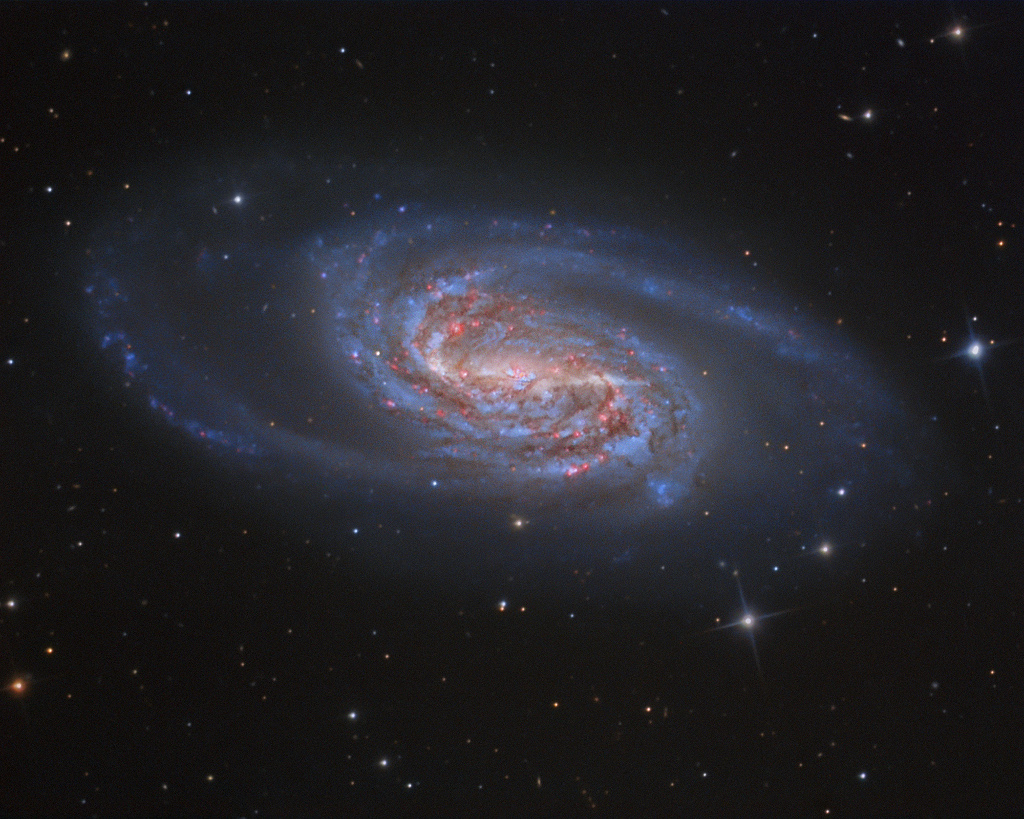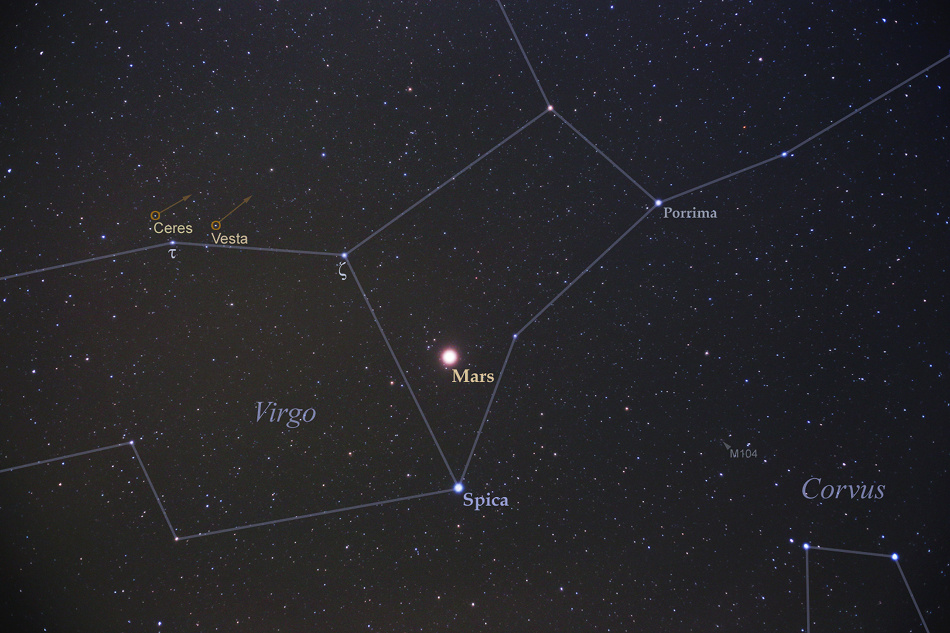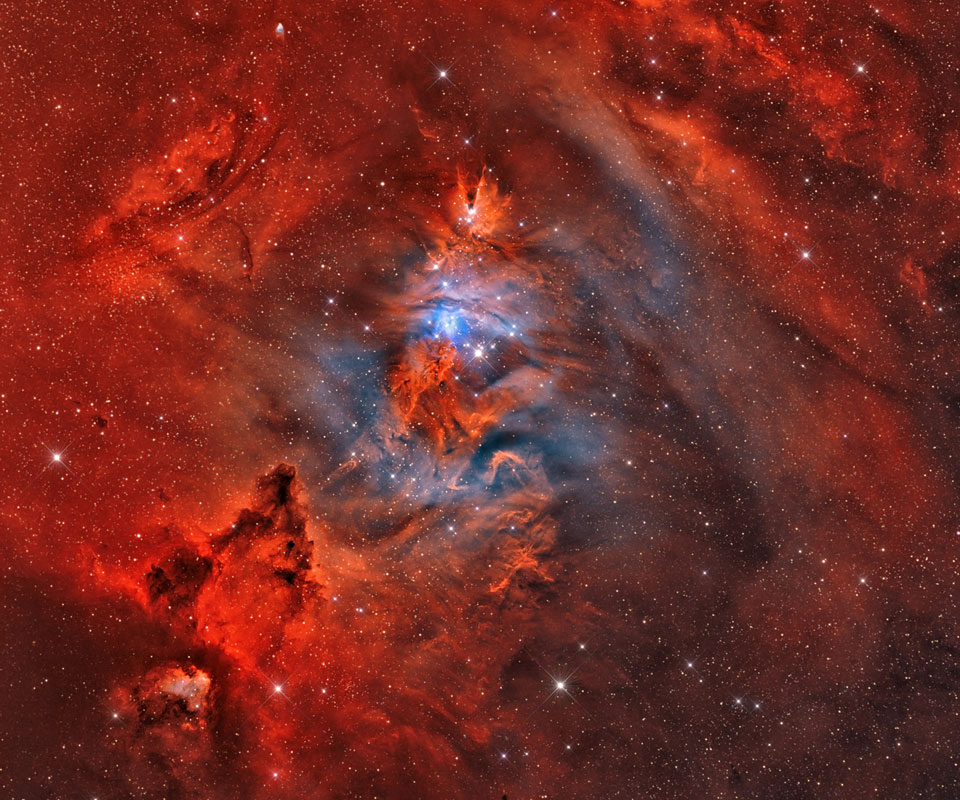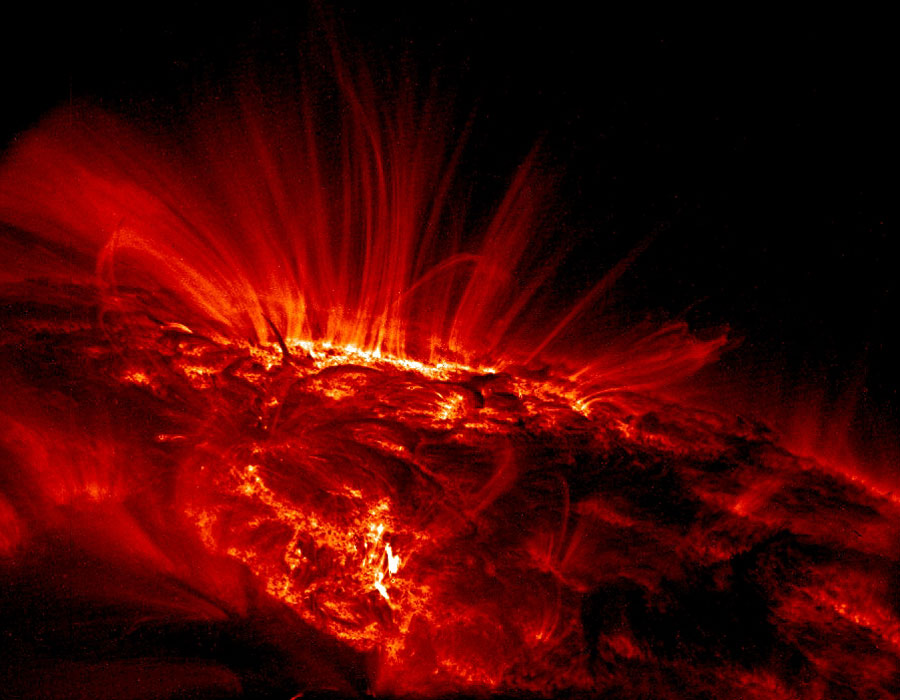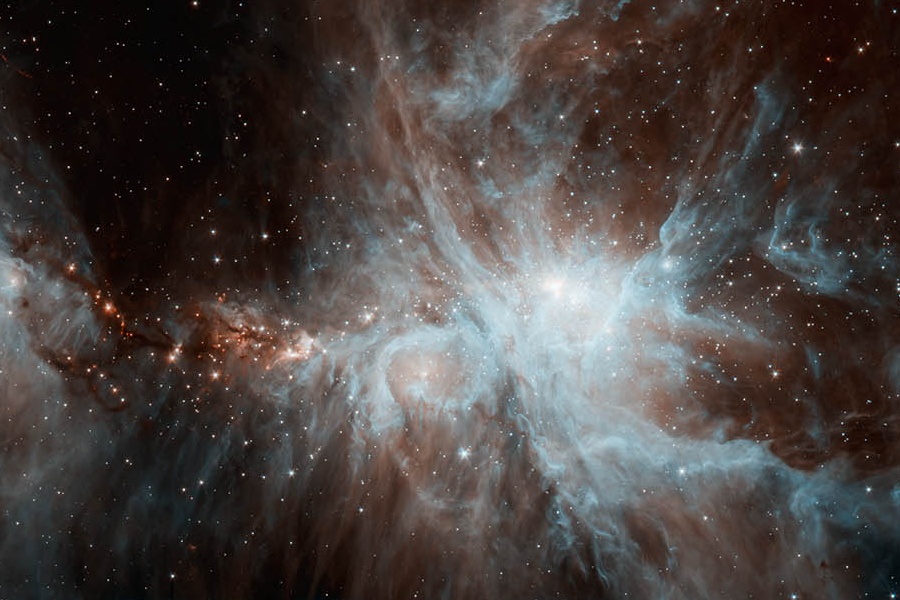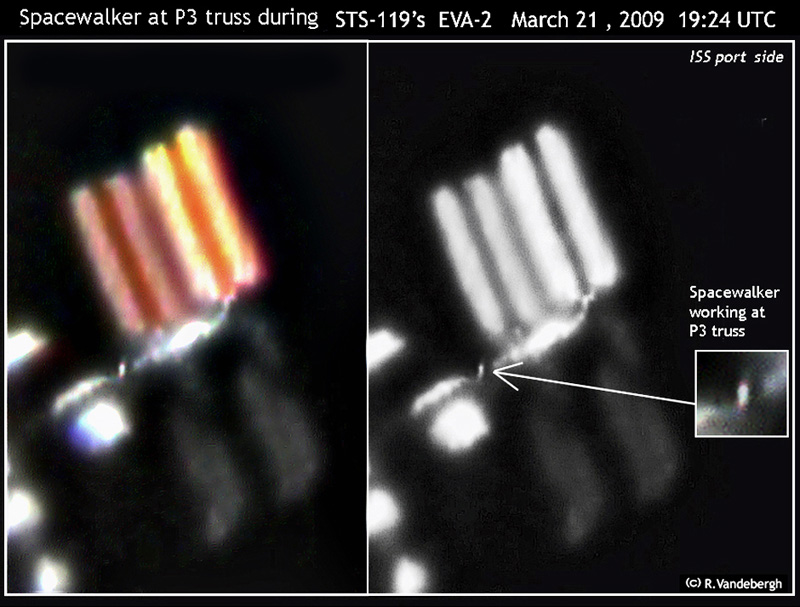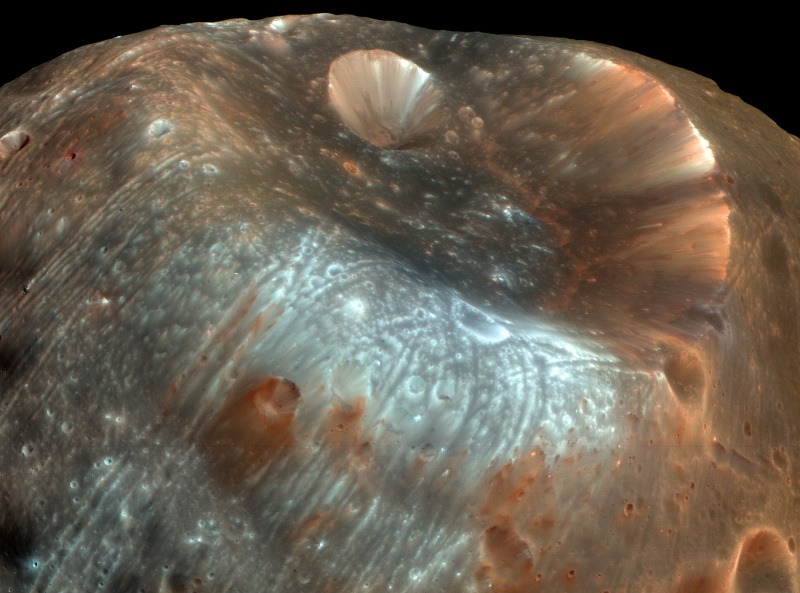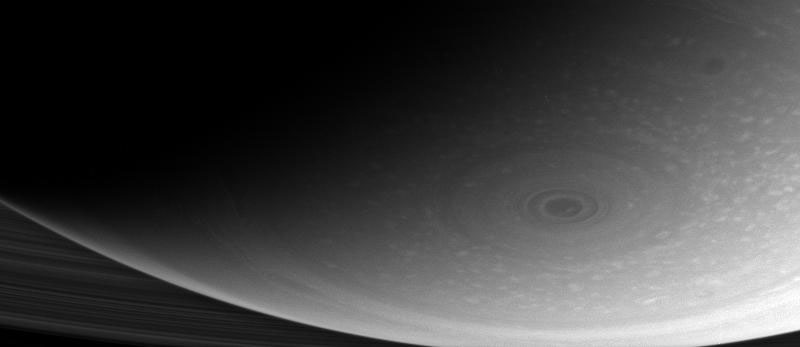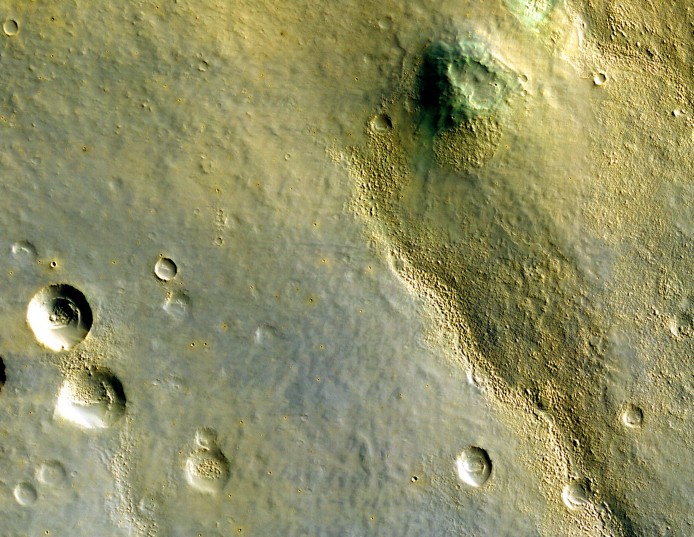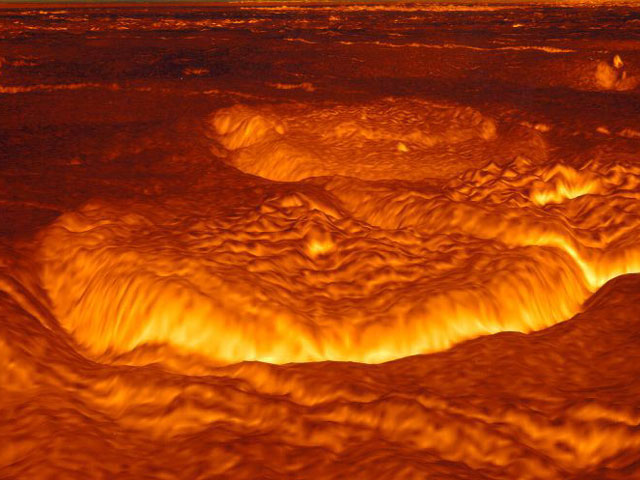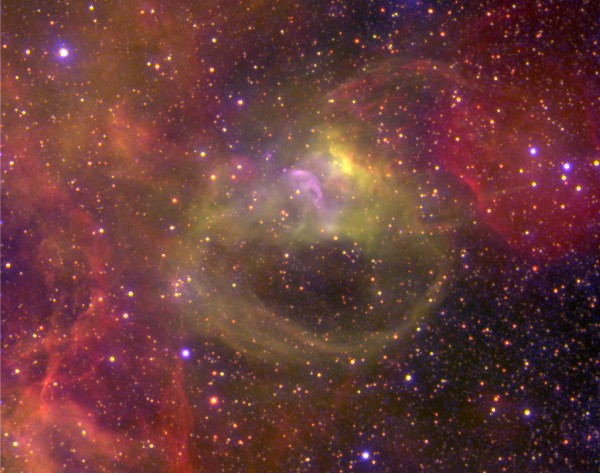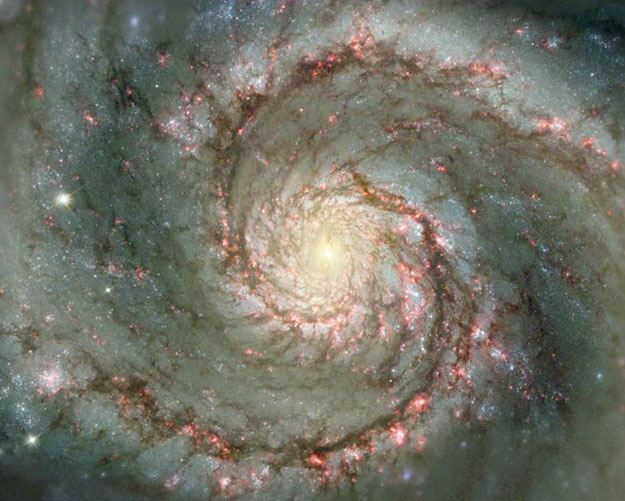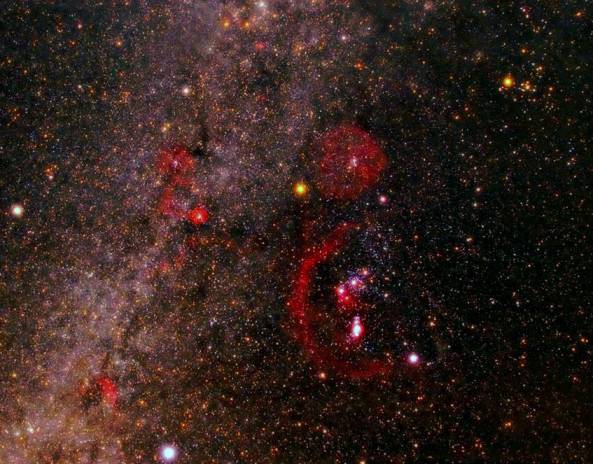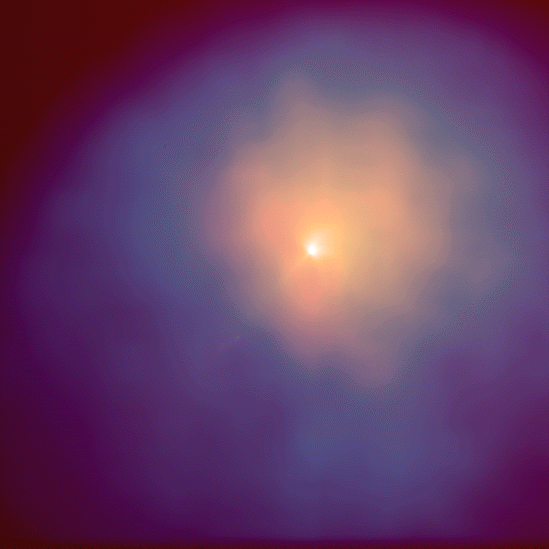| << Previous | Index | Next >> |
2015 Barred spiral galaxy NGC 2903 is only some 20 million light-years distant. Popular among amateur astronomers, it shines in the northern spring constellation Leo, near the top of the lion's head. That part of the constellation is sometimes seen as a reversed question mark or sickle. One of the brighter galaxies visible from the northern hemisphere, NGC 2903 is surprisingly missing from Charles Messier's catalog of lustrous celestial sights. This colorful image from a small ground-based telescope shows off the galaxy's gorgeous spiral arms traced by young, blue star clusters and pinkish star forming regions. Included are intriguing details of NGC 2903's bright core, a remarkable mix of old and young clusters with immense dust and gas clouds. In fact, NGC 2903 exhibits an exceptional rate of star formation activity near its center, also bright in radio, infrared, ultraviolet, and x-ray bands. Just a little smaller than our own Milky Way, NGC 2903 is about 80,000 light-years across.
2014 That bright, ruddy star you've recently noticed rising just after sunset isn't a star at all. That's Mars, the Red Planet. Mars is now near its 2014 opposition (April 8) and closest approach (April 14), looping through the constellation Virgo opposite the Sun in planet Earth's sky. Clearly outshining bluish Spica, alpha star of Virgo, Mars is centered in this labeled skyview from early April, that includes two other solar system worlds approaching their opposition. On the left, small and faint asteroid Vesta and dwarf planet Ceres are seen near star Tau Virginis. But you'll just have to imagine NASA's Dawn spacecraft cruising between the small worlds. Having left Vesta in September of 2012, Dawn's ion engine has been steadily driving it to match orbits with Ceres, scheduled to arrive there in February 2015. Of course, you can also look near Mars for the Moon opposite the Sun in Earth's sky on the night of April 14/15 ... and see a total lunar eclipse.
2013
[imghover6=http://apod.nasa.gov/apod/image/1304/lo ... s_1024.jpg]http://apod.nasa.gov/apod/image/1304/lo ... d_1024.jpg[/imghover6]Image Credit & Copyright: Chris Hadfield (CSA); Annotation assistance: Vincent Berseth
2012 What do the following things have in common: a cone, the fur of a fox, and a Christmas tree? Answer: they all occur in the constellation of the unicorn (Monoceros). Pictured above as a star forming region cataloged as NGC 2264, the complex jumble of cosmic gas and dust is about 2,700 light-years distant and mixes reddish emission nebulae excited by energetic light from newborn stars with dark interstellar dust clouds. Where the otherwise obscuring dust clouds lie close to the hot, young stars they also reflect starlight, forming blue reflection nebulae. The above image spans about 3/4 degree or nearly 1.5 full moons, covering 40 light-years at the distance of NGC 2264. Its cast of cosmic characters includes the Fox Fur Nebula, whose convoluted pelt lies below center, bright variable star S Mon immersed in the blue-tinted haze, and the Cone Nebula near the tree's top. Of course, the stars of NGC 2264 are also known as the Christmas Tree star cluster. The triangular tree shape traced by the stars appears sideways here, with its apex at the Cone Nebula and its broader base centered near S Mon.
2011 It was a quiet day on the Sun. The above image shows, however, that even during off days the Sun's surface is a busy place. Shown in ultraviolet light, the relatively cool dark regions have temperatures of thousands of degrees Celsius. Large sunspot group AR 9169 from the last solar cycle is visible as the bright area near the horizon. The bright glowing gas flowing around the sunspots has a temperature of over one million degrees Celsius. The reason for the high temperatures is unknown but thought to be related to the rapidly changing magnetic field loops that channel solar plasma. Large sunspot group AR 9169 moved across the Sun during 2000 September and decayed in a few weeks.
2010 Few cosmic vistas excite the imagination like the Orion Nebula, an immense stellar nursery some 1,500 light-years away. Spanning about 40 light-years across the region, this new infrared image from the Spitzer Space Telescope was constructed from data intended to monitor the brightness of the nebula's young stars, many still surrounded by dusty, planet-forming disks. Orion's young stars are only about 1 million years old, compared to the Sun's age of 4.6 billion years. The region's hottest stars are found in the Trapezium Cluster, the brightest cluster near picture center. Spitzer's liquid helium coolant ran out in May 2009, so this false color view is from two channels that still remain sensitive to infrared light at warmer operating temperatures.
2009 These two frames, taken with a video camera and a telescope, reveal remarkable details of the International Space Station (ISS) orbiting some 350 kilometers above planet Earth. Recorded during last month's visit by the crew of shuttle orbiter Discovery on mission STS-119, the pictures show extended solar arrays glinting in bright sunlight against a dark sky. They also likely capture the blurred image of a spacewalking astronaut during the mission's EVA-2 (Extravehicular Activity-2)! The astronaut is installing equipment along one of the station's truss assemblies. Astronomer Ralf Vandebergh, who often images the ISS during its favorable passes through Dutch skies, comments that no other bright ISS structures occupy the position indicated in the inset, and that a reflective, white-suited astronaut would be visible against the truss and correspond to the bright blur. Vandebergh notes that the timing and location further suggest the spacewalker is STS-119 astronaut Joseph Acaba.
2008 Stickney Crater, the largest crater on the martian moon Phobos, is named for Chloe Angeline Stickney Hall, mathematician and wife of astronomer Asaph Hall. Asaph Hall discovered both the Red Planet's moons in 1877. Over 9 kilometers across, Stickney is nearly half the diameter of Phobos itself, so large that the impact that blasted out the crater likely came close to shattering the tiny moon. This stunning, enhanced-color image of Stickney and surroundings was recorded by the HiRISE camera onboard the Mars Reconnaissance Orbiter as it passed within some six thousand kilometers of Phobos last month. Even though the surface gravity of asteroid-like Phobos is less than 1/1000th Earth's gravity, streaks suggest loose material has slid down inside the crater walls over time. Light bluish regions near the crater's rim could indicate a relatively freshly exposed surface. The origin of the curious grooves along the surface is mysterious but may be related to the crater-forming impact.
2007 Swooping below Saturn, the Cassini spacecraft spied several strange wonders. Visible in the distance are some of the many complex rings that orbit the Solar System's second largest planet. In the foreground looms the gigantic world itself, covered with white dots that are clouds high in Saturn's thick atmosphere. Saturn's atmosphere is so thick that only clouds are visible. At the very South Pole of Saturn lies a huge vortex that is a hurricane-like storm showing no sign of dissipating. The robotic Cassini spacecraft took the above image in January from about one million kilometers out, resolving details about 50 kilometers across.
2006 HiRISE - the High Resolution Imaging Science Experiment - rides on the Mars Reconnaissance Orbiter (MRO)spacecraft just arrived in Mars orbit on March 10. This sharp view of the martian surface from the HiRISE camera includes image data with a full resolution of about 2.5 meters per pixel - recorded from a range of 2,500 kilometers. In the coming months, MRO's orbit will be circularized through repeated passages into Mars' outer atmosphere, a process known as aerobraking, shrinking its orbit to an altitude of only 280 kilometers. At that distance, the HiRISE experiment should be able to image the Red Planet's surface at a resolution of 28 centimeters (11 inches) per pixel. In this first color image, the false colors represent HiRISE's visible and infrared imaging data combined. The picture is nearly 24 kilometers wide and covers an area in the Bosporos Planum region of southern Mars.
2005 If you could look at Venus with radar eyes - this is what you might see. This computer reconstruction of the surface of Venus was created from data from the Magellan spacecraft. Magellan orbited Venus and used radar to map our neighboring planet's surface between 1990 and 1994. Magellan found many interesting surface features, including the large circular domes, typically 25-kilometers across, that are depicted above. Volcanism is thought to have created the domes, although the precise mechanism remains unknown. Venus' surface is so hot and hostile that no surface probe has lasted more than a few minutes.
2004 From our vantage point in the Milky Way Galaxy, we see NGC 6946 face-on. The big beautiful spiral galaxy is located just 10 million light-years away, behind a veil of foreground stars in the high and far-off constellation of Cepheus. Looking from the bright core outward along the loose, fragmented spiral arms, the galaxy's colors show a striking change from the yellowish light of old stars in the galaxy's center to young blue star clusters and reddish star forming regions. NGC 6946 is also bright in infrared light and rich in gas and dust, exhibiting a high star birth and death rate. In fact, during the 20th century, at least six supernovae, the death explosions of massive stars, were discovered in NGC 6946. In this sharp composite color digital image, a small barred structure is just visible at the gorgeous galaxy's core.
2003 Blossoming in nearby galaxy the Large Magellanic Cloud (LMC), this gorgeous nebula is energized by radiation and winds from a massive star whose surface temperature approaches 100,000 degrees. The composite color image from the European Southern Observatory's Melipal telescope resolves details in the energetic nebula, with emission from helium atoms in blue hues, oxygen atoms in green, and hydrogen atoms in red. While emission nebulae generally show the familiar red light from ionized hydrogen atoms - hydrogen atoms with their electrons stripped away - ionized helium atoms are tracers of even higher energy interactions. The intriguing filaments of helium emission make this and other recently studied emission nebulae most exceptional. A Wolf-Rayet star, the massive star powering this nebula, created a cosmic bubble with stellar winds in the early stages of its life. Part of the bubble is still apparent as the large arc in the lower portion of the image. The area pictured is about 150 light-years across.
2002 How did those big rocks end up on that strange terrain? One of the more unusual places here on Earth occurs inside Death Valley, California, USA. There a dried lakebed named Racetrack Playa exists that is almost perfectly flat, with the odd exception of some very large stones, one of which is pictured above. Now the flatness and texture of large playa like Racetrack are fascinating but not scientifically puzzling -- they are caused by mud flowing, drying, and cracking after a heavy rain. Only recently, however, has a viable scientific hypothesis been given to explain how 300-kilogram stones ended up near the middle of such a large flat surface. Unfortunately, as frequently happens in science, a seemingly surreal problem ends up having a relatively mundane solution. It turns out that high winds after a rain can push even heavy rocks across a momentarily slick lakebed.
2001 The Whirlpool Galaxy is a classic spiral galaxy. At only 30 million light years distant and fully 60 thousand light years across, M51, also known as NGC 5194, is one of the brightest and most picturesque galaxies on the sky. The above image is a digital combination of a ground-based image from the 0.9-meter telescope at Kitt Peak National Observatory and a space-based image from the Hubble Space Telescope highlighting sharp features normally too red to be seen. Anyone with a good pair of binoculars, however, can see this Whirlpool toward the constellation of Canes Venatici. M51 is a spiral galaxy of type Sc and is the dominant member of a whole group of galaxies. Astronomers speculate that M51's spiral structure is primarily due to its gravitational interaction with a smaller galaxy just off the top of this image.
2000 The past week brought some spectacular aurora to northern skies. These aurorae were caused by a large interplanetary shock wave that exploded from the Sun on April 4. When the shock wave reached the Earth on April 6, the resulting aurora could be seen in clear skies as far south as North Carolina. As the aurorae occurred high in the Earth's atmosphere, they were accompanied by an unusual alignment of planets far in the background. Pictured above that night, an unusual multicolored auroral display graced the skies above the domes of the Brno Observatory in the Czech Republic.
1999 This gorgeous view of stars, nebulae, and the Milky Way comes from the dark night sky above the lovely island of La Palma in the Canaries archipelago. The picture was made by a group of experienced astrophotographers who traveled there to take advantage of the ideal observing conditions near La Palma's Observatorio del Roque de los Muchachos. Skygazers can easily pick out several of their favorite astronomical objects in this wide angle time exposure which covers about 40 degrees on winter the sky. Faint stars along the plane of our Galaxy compose the delicate, luminous band of the Milky Way stretching across the image from the bottom left. The familiar constellation of Orion the hunter is also easy to find, with glowing nebulae highlighting the hunter's belt and sword. Orion's famous red giant star Betelgeuse, near picture center, has a yellowish cast and Rigel is the bright star in Orion at lower right. Brilliant white Sirius, near the bottom, is the brightest star in the picture (and in Earth's night sky). Sirius, is part of the constellation Canis Major (Big Dog). Across the Milky Way, above and to the left of Sirius, is slightly less brilliant Procyon, brightest star of Canis Minor. A V-shaped group of yellowish stars at the upper right, part of Taurus the bull, is dominated by the red giant Aldebaran.
1998 The atmosphere of a comet comes and goes. Approaching the sun, it swells as material from the icy cometary nucleus is warmed and evaporated by increasing sunlight. Immense but tenuous and fleeting, the inner atmosphere or inner "coma" of comet Hyakutake is seen in this false color picture. Oriented with the sunward direction toward the upper right, the picture is a composite of Hubble Space Telescope images recorded on April 3 and 4, 1996. It is about 14,000 km across (comparable to Earth's diameter) and is a combination of images showing dust reflected light (red) and ultraviolet light scattered from Hydrogen atoms (blue). Hyakutake's Hydrogen atoms were produced by the breakup of water (H20) molecules evaporating from its nucleus. The Hydrogen data, combined with other observations, indicate that this comet's nucleus, itself only a few km across, was producing about 7 to 8 tons of water per second.
1997 The surface of Jupiter's moon Europa has shifted. Photographs released yesterday of Europa's surface taken by the spacecraft Galileo show that the smooth moon's icy surface is sometimes like a giant scrambled jigsaw puzzle. Pieces of Europa's surface, identifiable above, have rafted to new locations. Also visible are larger areas that are clearly shifted from their original alignment. What could cause this surface shuffle? One leading explanation is water - oceans of water just beneath Europa's ice plains. This discovery again fuels speculation that life might exist far from the comfort of Earth.
1996 Comet Hyakutake is still visible as it continues its orbit around the Sun. The comet will brighten again in late April and early May. The above fascinating picture was taken with a three minute exposure. In the middle of the exposure, the photographer cleverly set off a flash, momentarily illuminating the foreground tree. The picture was taken on March 24th from Mount Teide in the Canary Islands, and the recorded tail length was over 50 degrees. Discoverer Yuji Hyakutake, whose last name means "100 warriors" is an amateur astronomer in Japan. Interested in comets since age 15, he discovered this comet while sitting on a rural mountain top searching dark skies with huge binoculars in early morning hours. Originally intending to check up on a comet he had discovered only one month earlier, Hyakutake was initially worried that the new fuzzy spot he had located was not really yet another comet! One unexpected result of his comet discovery is that now his family has trouble making phone calls because their telephone is always ringing.
| << Previous | Index | Next >> |
